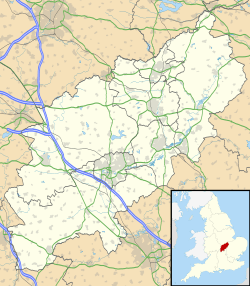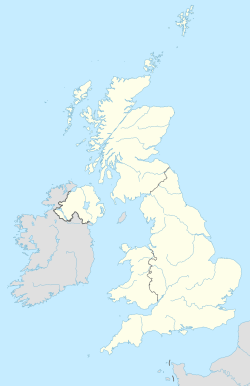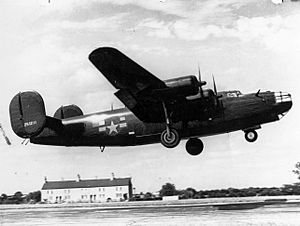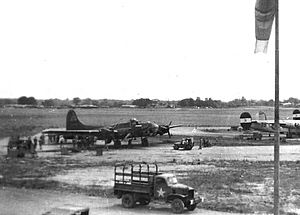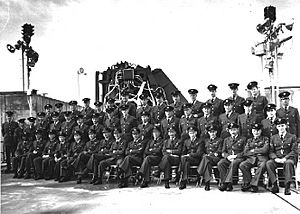RAF Harrington facts for kids
Quick facts for kids RAF HarringtonUSAAF Station 179 |
|||||||||||
|---|---|---|---|---|---|---|---|---|---|---|---|
| Kettering, Northamptonshire in England | |||||||||||

Aerial photograph of Harrington airfield looking north, the main runway runs vertically, 22 April 1944. Note the many aircraft of the 801st Bombardment Group on the various hardstands, also one appearing to be taking off on the main runway.
|
|||||||||||
|
Shown within Northamptonshire
|
|||||||||||
| Coordinates | 52°23′34″N 000°51′43″W / 52.39278°N 0.86194°W | ||||||||||
| Type | Royal Air Force station | ||||||||||
| Code | HR | ||||||||||
| Site information | |||||||||||
| Owner | Ministry of Defence | ||||||||||
| Operator | Royal Air Force United States Army Air Forces |
||||||||||
| Controlled by | RAF Bomber Command * No. 92 (OTU) Group RAF Eighth Air Force |
||||||||||
| Site history | |||||||||||
| Built | 1943 | ||||||||||
| Built by | 826th & 852nd Engineer Battalions, US Army | ||||||||||
| In use | 9 November 1943 – 1945, 1958 – 23 January 1963 | ||||||||||
| Battles/wars | European theatre of World War II Cold War |
||||||||||
| Airfield information | |||||||||||
| Elevation | 158 metres (518 ft) AMSL | ||||||||||
|
|||||||||||
RAF Harrington was once an important air base in England. It is located about 5.6 miles (9.0 km) west of Kettering in Northamptonshire. This former Royal Air Force station played a big role during World War II and later in the Cold War.
During the Cold War, RAF Harrington became a special site for Thor missiles. These were powerful rockets designed to carry warheads. Today, the old missile site is a protected historic place, showing what Cold War buildings looked like.
Contents
History of RAF Harrington
World War II: United States Army Air Forces
The airfield at Harrington first opened in September 1943. It was built by American Army engineers, the 826th and 852nd Engineer Battalions. The base was designed for large bomber planes and was ready by spring 1944.
The United States Army Air Forces (USAAF) used Harrington as Station 179. Many different groups of soldiers and support staff worked here. They helped keep the base running and supported the flying missions.
The "Carpetbaggers" and Secret Missions
The first USAAF group to arrive at Harrington was the 801st Bombardment Group (Provisional) in March 1944. This group became famous as the "Carpetbaggers." Their job was to fly secret missions.
The Carpetbaggers delivered supplies and agents to resistance groups in countries occupied by enemy forces. They used Consolidated B-24 Liberator planes for these important tasks.
Their B-24 Liberators were specially changed for these missions. Most of their weapons were removed, and special equipment was added to drop supplies. The planes were painted black on the bottom to make them harder to see at night. Pilots flew deep into enemy territory to make their drops. They also flew further after dropping supplies to confuse enemy observers.
The Carpetbaggers also dropped millions of leaflets over many European countries. These leaflets shared war news and encouraged enemy soldiers to surrender. They were a trusted source of information for people living under occupation. Having one of these leaflets was very dangerous if caught by the enemy.
The 492d Bombardment Group (Heavy)
In August 1944, the 801st Bombardment Group became part of the 492d Bombardment Group (Heavy). The 492d had faced many losses before coming to Harrington. The new group continued the important "Carpetbagger" missions.
For a time, the group stopped "Carpetbagger" missions. They helped transport fuel to advancing forces and attacked enemy targets. Later, some squadrons switched to night bombing. This was tricky because their planes had been changed for special operations.
By March 1945, the 492d returned to its secret "Carpetbagger" work. They used B-24s, A-26s, and British Mosquito aircraft. They dropped leaflets, demolition equipment, and agents over Germany and occupied areas. The group earned a special award, the Distinguished Unit Citation, for their brave night missions.
The 492d flew its last "Carpetbagger" mission in April 1945. After the war, the group was planned to use Boeing B-29 Super Fortress planes for missions over Japan. However, Japan surrendered, and these plans were cancelled. The group was then closed down in October 1945.
Cold War: Thor Missile Site
After World War II, RAF Harrington was mostly unused and returned to farmland. But in 1958, it became important again. It was chosen as one of the RAF's Thor missile sites.
Three rocket launch pads were built, along with other buildings. This whole area was made a top-security zone with fences and bright lights. The Thor missile system was a powerful rocket that could travel 1,500 nautical miles (2,780 km). It was used by RAF Bomber Command until 1963. By then, newer V-bomber aircraft took over its role.
In 2011, the Thor missile site at Harrington was given Grade II listed status. This means it is a protected historic building. It is an important example of Cold War architecture. Dr. Simon Thurley of English Heritage said these sites are like "castles and forts of the second half of the 20th century." They help us remember this important time in history.
Current Use of the Airfield
After the Thor missiles were removed, Harrington went back to being farmland. Most of the concrete runways and paths were taken away. Today, you can still see some old farm roads that follow where the airfield used to be. The three Thor Missile launch pads are also still visible.
Carpetbagger Aviation Museum
The Carpetbagger Aviation Museum opened in 1993. It tells the story of RAF Harrington and the brave 801st Bombardment Group. The museum also shows the secret work of the Special Operations Executive and the Cold War Thor missiles.
You can also find the Northants Aviation Society Museum here. It has parts of World War II aircraft, items from life during the war, and military souvenirs. The local Kettering and District Amateur Radio Society also has its station at the museum site.
Wind Park Plans
There are plans to build a wind park at this old airfield. Vattenfall United Kingdom is thinking about putting up seven large wind turbines. These turbines could produce 14 megawatts of clean energy.
See also
- List of former Royal Air Force stations



